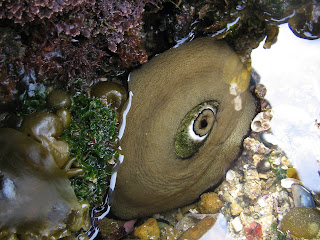 Common name: California poppy
Common name: California poppyScientific name: Eschscholzia californica
Range: southern Washington to northern Baja California, east to Nevada and Sonoran desert southwest
More information: The California poppy is a stunningly colorful and elegantly simple flower to behold. Here are five interesting facts about Eschscholzia californica (source: Wikipedia):
1. It is the state flower of California.
If you enter the state by road, you'll be keen to this immediately (it's on the welcome signs). It also graces the road signs for scenic routes, and lots of "Greetings from California!" postcards. Apparently, it was adopted as state flower around the turn of the last century--by a landslide vote over the Mariposa lily and the Matilija poppy.
2. It was named for Johann Friedrich von Eschscholtz, one of many 19th century naturalists who helped to explore and catalogue many taxonomically unchartered islands and territories of the "Far Side of the World"--particularly much Californian flora and fauna. He was also, in my opinion, a handsome fellow.
 Eschscholtz, a Baltic-German, was professor of anatomy and director of zoological cabinet at the University of Tartu (which is located in present-day Estonia, then Imperial Russia). From 1815-1818 he was ship's physician and naturalist on the Russian circumnavigational expeditionary ship Rurik, a voyage which enabled him to collect along the rim of the Bering Sea, the Pacific Islands, California, and South America. (Says Wikipedia, "The other naturalist was the botanist Adelbert von Chamisso who took over Eschscholtz’ specimens excepting insects on completion of the voyage. The two were close friends and Chamisso named the California poppy Eschscholtzia californica in his honor.") On a later voyage, Eschscholtz returned to California where he collected over 100 unique species of beetles near Fort Ross, the southernmost Russian fort. (You know that the Creator loves beetles, right?)
Eschscholtz, a Baltic-German, was professor of anatomy and director of zoological cabinet at the University of Tartu (which is located in present-day Estonia, then Imperial Russia). From 1815-1818 he was ship's physician and naturalist on the Russian circumnavigational expeditionary ship Rurik, a voyage which enabled him to collect along the rim of the Bering Sea, the Pacific Islands, California, and South America. (Says Wikipedia, "The other naturalist was the botanist Adelbert von Chamisso who took over Eschscholtz’ specimens excepting insects on completion of the voyage. The two were close friends and Chamisso named the California poppy Eschscholtzia californica in his honor.") On a later voyage, Eschscholtz returned to California where he collected over 100 unique species of beetles near Fort Ross, the southernmost Russian fort. (You know that the Creator loves beetles, right?)3. In places where it has been introduced, it seems to be even more successful than in its native range.
According to Wikipedia: "Because of its beauty and ease of growing, the California poppy was introduced into several regions with similar Mediterranean climates. It is commercially sold and widely naturalized in Australia, and was introduced to South Africa, Chile, and Argentina....
"Introduced populations have been noted to be larger and more reproductively successful than native ones (Elton, 1958), and there has been much speculation as to why. Increase in resource availability, decreased competition, and release from enemy pressure have all been proposed as explanations.
"One hypothesis is that the resources devoted in the native range to a defense strategy, can in the absence of enemies be devoted to increased growth and reproduction (the EICA hypothesis, Blossey & Nötzold, 1995). However, this is not the case with introduced populations of E. californica in Chile: the Chilean populations were actually more resistant to Californian caterpillars than the native populations (Leger and Forister, 2005)."
4. It is reported that at the peak of blooming season, orange petals seem to cover all 1,745 acres of the Antelope Valley California Poppy Reserve.
 Antelope Valley is located in northern Los Angeles County. (This is definitely going on my list of places to visit!)
Antelope Valley is located in northern Los Angeles County. (This is definitely going on my list of places to visit!)5. As with other members of the Poppy family, it contains narcotic alkaloids, which have sedative and analgesic properties.
According to reports, however, these properties are relatively mild in the California poppy. Hmm... does that mean Elaine should have eaten California poppy seed muffins, instead of Opium ones?









 Scientific name:
Scientific name: 




















